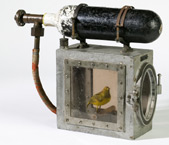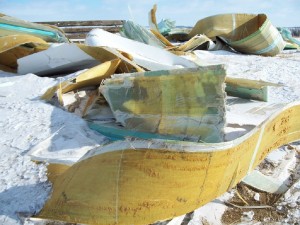Circular letter from Pollution Control Agency
September 14th, 2016

From the “Circular Logic” department, the Minnesota Pollution Control Agency responded to my rulemaking Petition, looking for them to set wind turbine noise standards, specifically infrasound standards:
And here’s the response:
The bottom line… the full letter:
After consulting with colleagues at the Minnesota Departments of Health and Commerce, I have concluded that the current understanding of wind turbine noise and its potential effects is insufficient to support rulemaking at this time. Discussions will continue among the agencies listed above, and we will monitor the science (as resources allow) to inform our decision about rulemaking in the future.
Right… And note there was no consultation with the Environmental Quality Board.
On to the next step. It never ends.
For more info, check the video of testimony of Rick James, INCE, at the Goodhue Wind Project public hearing:
Rick James testimony for Goodhue Wind Truth
And prefiled testimony:
testimony of Richard R. James, INCE, for Wednesday’s hearing over in Goodhue:
A must read:
The “How-To” Guide to Siting Wind Turbines to Prevent Health Risks from Sound
And this was published earlier this month:

Dr. Gary Carlson’s wind Commentary in STrib
November 9th, 2010
In yesterday’s STrib there was a Commentary written by Dr. Gary Carlson, of Northfield. He gave a very accurate impression of what it is to go to a Rice County Planning Commission meeting. FRUSTRATING! To put it mildly. He also has started digging into health impacts of wind. He’s put himself out as a canary:
Here’s his Commentary:
Gary Carlson: Wind energy’s ripple effects
Once I learned how turbines can affect people, I had to speak up.I know environmental sensitivity; these are the patients I take care of every day.
We lost four and tied one (tabled for now). I felt devastated.
Live from the PUC!
February 1st, 2010
Except that now there’s a delayed start, we’re missing a Commissioner…
Here’s some notes, we’re taking a break — I’m missing some parts, but here we go:
OK, the “ROUGH notes” are their in toto, but hey, I’ve got something better:
HERE’S THE MEETING – February 1 Agenda Meeting
You may have to download “Silverlight” to view the meeting.
PUC’s Health Impacts of Wind Turbine Docket
January 26th, 2010
9:30 a.m. on February 1, 2010
Minnesota Public Utilities Commission
Large Hearing Room
121 – 7th Place E., 3rd Floor
St. Paul, MN 55101
Remember the PUC’s docket that they opened after release of:
Apparently they’re looking at doing something — and here’s what the staff Briefing Papers say:
Here’s how staff defines the issue before the PUC:
Should the Commission find that current permit conditions regarding setbacks remain appropriate and reasonable in light of recent concern and the Minnesota Department of Health’s White Paper, Public Health Impacts of Wind Turbines?
And here’s the bottom line, what staff thinks should happen:
Staff recommends that the best approach to mitigate the issues discussed above would be comprised of two modifications to our current process.
1) Increase setbacks from non-participating landowner residences
a. Continue to use the existing 500-foot or noise standard residential setback (whichever is greater) to allow participating landowners to maximum their land use.
b. Increase the setback required from non-participating landowner residences to 1,000 feet or the state noise standard (whichever is greater) or some other number deemed appropriate by the Commission.
2) Require additional information from developers during the siting process to provide accurate and specific information to the Commission on the impacts of the project. Staff will continue to work on refining the specifics of these requests, additional information is anticipated to be (at a minimum, but could be subject to change):
a. During the application process:
I. noise modeling report (at different frequencies and at various distances from the turbines at various wind directions and speeds) throughout the project area;
II. if flicker is to occur on non-participating residences, shadow flicker modeling report, indicating anticipated maximum;
b. Preconstruction (submitted at time of final site layout):
I. final noise modeling report of final layout and noise monitoring proposal (both at different frequencies and at various distances from the turbines at various wind directions and speeds) throughout the project area;
II. final shadow flicker modeling report;
c. Post construction:
I. noise monitoring reports of the development (at different frequencies and at various distances from the turbines at various wind directions and speeds) throughout the project area.
To check out the whole docket and look at the various comments, CLICK HERE FOR PUC SEARCH PAGE , then scroll down a bit to the “Search” button and below that enter 09-845 and then click “Search.” Voila, there it all is!
So, be there or be square.
9:30 a.m. on February 1, 2010
Minnesota Public Utilities Commission
Large Hearing Room
121 – 7th Place E., 3rd Floor
St. Paul, MN 55101
Wind Investigation Comments In, Replies Due
September 23rd, 2009
Failed Suzlon turbine scattered on Minnesota snow
The PUC’s Wind Investigation looking at the MN Dept of Health – Public Health Impacts of Wind Turbines report and setbacks is moving forward. Here’s the report that apparently got them thinking:
The initial Comments are in. To see them:
- Go to www.puc.state.mn.us
- Click on eDockets
- Search for Docket 09-845
Reply Comments are due October 13th, and you’ll find reminders here!


